The New Normal
Posted in: UncategorizedIt’s not everyday that Dick Cheney gives its title to an art exhibition.
In the weeks following September 11, the U.S. Vice President justified a steep increase of surveillance measures by explaining that “Many of the steps we have now been forced to take will become permanent in American life. They represent an understanding of the world as it is, and dangers we must guard against perhaps for decades to come. I think of it as the new normalcy.” Almost 7 years later, the collection and sharing of personal data by governments, luggage searches, Internet monitoring, and wiretaps have indeed become part of a “new normal” in American life.
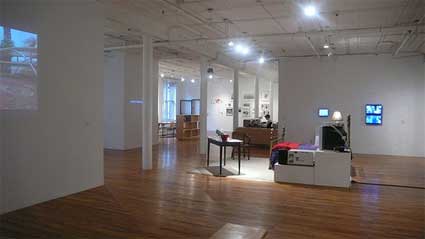
View of the exhibition space
The New Normal brings together thirteen artworks which explore private information. All the works have been developed after 2001, the year that ctrl[space] : Rhetorics of Surveillance, a major exhibition on privacy and surveillance opened at the ZKM center in Karlsruhe, Germany. It’s not a redux of the exhibition: new factors have changed the surveillance panorama since the ZKM exhibition opened. There’s President Bush signing the Patriot Act on October 26, 2001, the number and efficiency of technologies of surveillance have skyrocketed and we have come to accept the new state of “normality”.
The New Normal reveals how difficult it is to set clear boundaries around the concept of privacy. The private sphere encompasses domestic spaces, personal data, the content of your pocket, bodies, thoughts, communication, and behaviors–contexts that are usually rendered inaccessible to the public eye by legal, social, and physical boundaries.
What is most remarkable about the show is the subtle way it engages with the complex concept of privacy. The videos and installations do not hammer their messages on your head, you’re not told what to think and what to be very afraid about. Instead, the exhibition argues that today’s society is indeed living Cheney’s new normal life but this doesn’t meant that the new condition of public disclosure cannot be harnessed in the service of artistic endeavours and the creation of “tactics for political critique.”
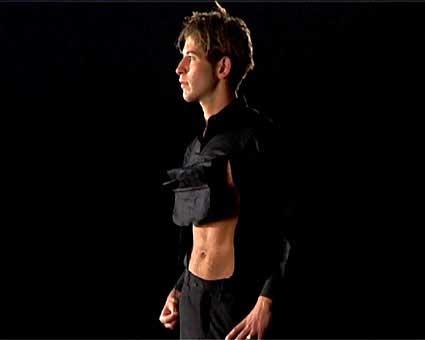
Videostill
Submitting oneself to security measures can be turned upside down by adopting what Hassan Elahi calls an “aggressive compliance”. Elahi daily points a mocking finger to absurd security measures with the real-time self-tracking website he set up in a bid to demonstrate to the FBI investigator that he’s not spending his time traveling to the Middle East and plotting some attack in the U.S. The models features in Sharif Waked‘s Chic Point Fashion for Israeli Checkpoints video seem to have adopted a similar strategy.
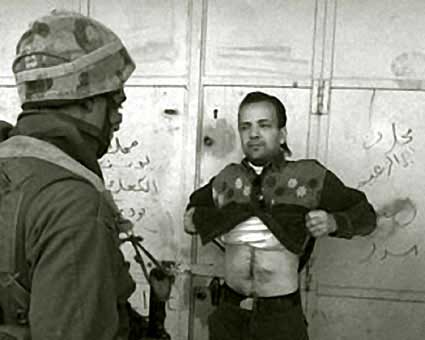
Videostill
Sharif Waked’s video features male models catwalking in clothes designed to expose the flesh of body parts such as chests and abdomens. It would be hilarious and cheeky were the images not juxtaposed with stills taken from recent years displaying Palestinian men having to lift their shirts, take off their pants and kneel shirtless in order to be authorized to cross Israeli checkpoints. The absurd pieces of clothing evoke the bodily humiliation experienced by Palestinians at Israeli checkpoints.
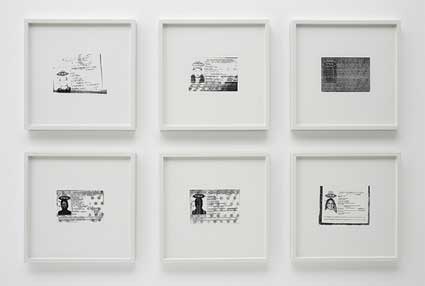
Six CIA Officers Wanted in Connection with the Abduction of Abu Omar from Milan, Italy. Courtesy the artist and Bellwether Gallery, New York
Equally politically-loaded is the series of badly photocopies of passports of CIA agents researched by Italian authorities in connection with the abduction of radical Egyptian cleric Abu Omar. On February 17, 2003, Abu Omar disappeared off the streets of Milan. The man had been kidnapped by the CIA, transferred to Cairo, where he was secluded, interrogated and allegedly tortured and abused. He was released 4 years later. The Imam Rapito (or “kidnapped Imam”) affair prompted a series of investigations in Italy.
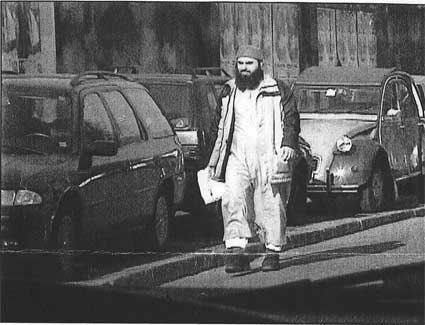
Twenty-six Americans were submitted to a trial in absentia along with several former Italian intelligence officials for their role in this case of extraordinary rendition. Trevor Paglen managed to get a copy of the photocopy of the fake passports that the agents had to deliver while they were checking in posh hotels in Italy in preparation for the kidnapping. The documents were released by Italian prosecutors in 2005. Although every element appearing on the identity document is fake, the picture had to be authentic. This ensured that the cover of the agents was blown and that the surveillance tools used by a government to achieve questionable goals can also become an instrument of justice.
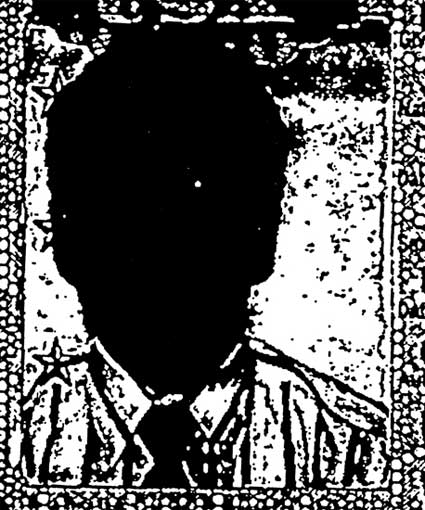
James Thomas Harbison (CIA Officer Wanted in Connection with the Abduction of Abu Omar from Milan, Italy). Courtesy the artist and Bellwether Gallery, New York
Relationships feed on bits of private information, it’s a currency we exchange with other people. Jill Magid‘s performance, photos and video Lincoln Ocean Victor Eddy not only illustrates this concept but it also put a human face on the surveillance we are submitted to every day.
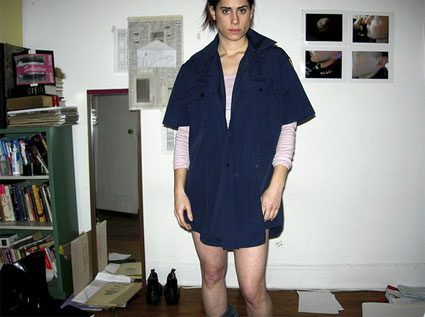
Jill Magid, His Shirt, Cropped (from Lincoln Ocean Victor Eddy), 2007. Courtesy Yvon Lambert Gallery, New York.
Back to New York City after five years spent in The Netherlands, Magid kept hearing this announcement in the subway “You may be a subject to searches “for security reasons”.” She approached a police officer and asked him to search her. He refused because only women officer had the right to search a woman but she managed to convince him to call her and tell her each night where he was on shift. She’d join him to be “trained” and kept record of the meetings in different forms: diary (read excerpts), photos, objects, etc. He would lend her his duty shirt, she’d give him a picture of her wearing it in return. She makes him tuna sandwiches, one day he allowed her to hold his gun. The relationship they build bit by bit is both intimate and somehow doomed: they are so different, the officer has never been to an art museum, Magid is “one of those liberals”.
Several works show that the intrusion into the private sphere is not just made of CCTV systems and biometric apparatus, it can also be voluntarily self-inflicted now that new online platforms called blogs, Facebook and image sharing call for self-disclosure.
As curator Michael Connor writes, Private information has never been less private.
The best example of this is probably the collection of videos that Guthrie Lonergan archived on you tube under the title MySpace Intro Playlist. Although they were made to be viewed by others, they convey an embarrassingly intimate echo once they have been decontextualized and exhibited in an art exhibition.
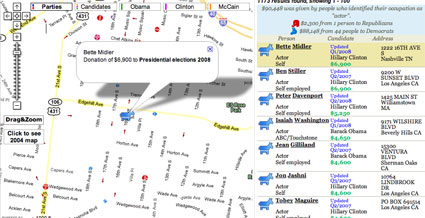
Developed by Michael Frumin during the 2004 Campaign in the U.S., FundRace is back. The website maps donation made to the candidates of the Presidential Election in the U.S. and enables you to search by name or address to see who your friends, co-workers, and neighbors are supporting. You can also search by profession and discover who celebs and museum curators are donating to.
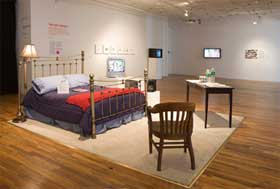 The revelation of famous people’s private requests almost makes you say thank you for a society which is so obsessed by the mundane facets of celebrities. Jennifer and Kevin McCoy‘s contribution to the exhibition is part of a series of sculptural displays of the products that musicians contractually require to be present in their dressing rooms after a performance. That’s where the loop closes and we get to cross path with Dick Cheney again. Band Rider Series (Dick Cheney) gives a glimpse into the very lack of spectacularity of Vice President’s desires when he travels to a new venue to give a talk: all tv sets have to be turned on FOX news, the hotel restaurant menu must be in his room along with bottles of water, etc.
The revelation of famous people’s private requests almost makes you say thank you for a society which is so obsessed by the mundane facets of celebrities. Jennifer and Kevin McCoy‘s contribution to the exhibition is part of a series of sculptural displays of the products that musicians contractually require to be present in their dressing rooms after a performance. That’s where the loop closes and we get to cross path with Dick Cheney again. Band Rider Series (Dick Cheney) gives a glimpse into the very lack of spectacularity of Vice President’s desires when he travels to a new venue to give a talk: all tv sets have to be turned on FOX news, the hotel restaurant menu must be in his room along with bottles of water, etc.
THE NEW NORMAL is a traveling exhibition co-organized by iCI (Independent Curators International), New York, and Artists Space, New York. It is on view at Artists Space until June 21, 2008.
Hasan Elahi at The Colbert Report:
Related: Sousveillance culture, Orwellian Projects, Book review – ctrl[space] : Rhetorics of Surveillance, Transmediale exhibition: Conspire, Trevor Paglen’s talk at Transmediale, etc.

Post a Comment